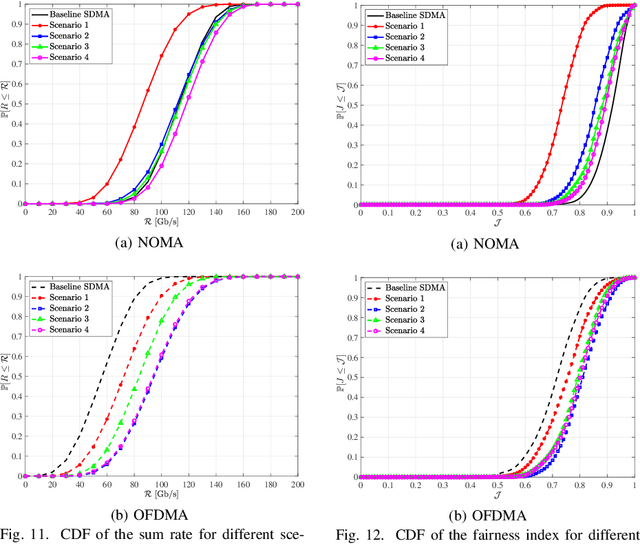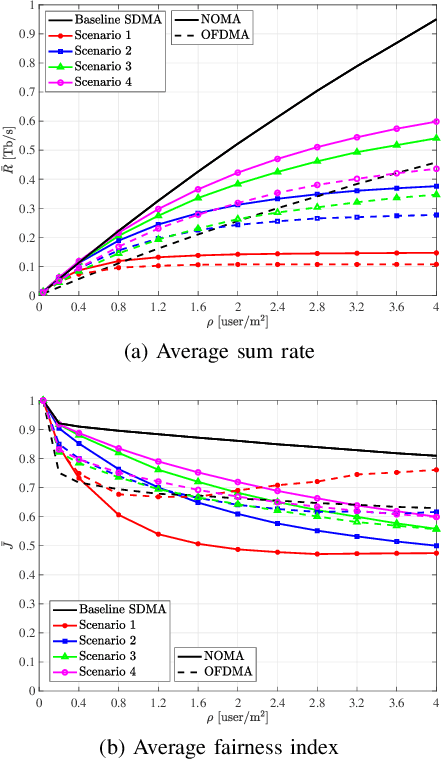Hossein Kazemi
Real-Time Transmission of Uncompressed High-Definition Video Via A VCSEL-Based Optical Wireless Link With Ultra-Low Latency
Jul 31, 2025Abstract:Real-time transmission of high-resolution video signals in an uncompressed and unencrypted format requires an ultra-reliable and low-latency communications (URLLC) medium with high bandwidth to maintain the quality of experience (QoE) for users. We put forward the design and experimental demonstration of a high-performance laser-based optical wireless communication (OWC) system that enables high-definition (HD) video transmission with submillisecond latencies. The serial digital interface (SDI) output of a camera is used to transmit the live video stream over an optical wireless link by directly modulating the SDI signal on the intensity of a 940 nm vertical cavity surface emitting laser (VCSEL). The proposed SDI over light fidelity (LiFi) system corroborates error-free transmission of full HD (FHD) and 4K ultra-high-definition (UHD) resolutions at data rates of 2.97 Gb/s and 5.94 Gb/s, respectively, with a measured end-to-end latency of under 35 ns. Since SDI standards support various video formats and VCSELs are high-bandwidth and low-power devices, this presents a scalable and inexpensive solution for wireless connectivity between professional broadcast equipment using off-the-shelf SDI components.
Achieving 70 Gb/s Over A VCSEL-Based Optical Wireless Link Using A Multi-Mode Fiber-Coupled Receiver
Jun 23, 2025Abstract:In this paper, we demonstrate a laser-based optical wireless communication (OWC) system employing a 940 nm single-mode (SM) vertical cavity surface emitting laser (VCSEL) and a multi-mode (MM) fiber-coupled receiver, achieving a record data rate beyond 70 Gb/s, while the optical transmit power is below 5 mW. The use of a high speed fiber-optic photoreceiver avoids limiting the communication bandwidth by the receiver, enabling ultra-high capacity and energy-efficient light fidelity (LiFi) links to unlock new applications. This work experimentally validates the feasibility of ultra-high speed indoor OWC systems using a single low-power and low-cost VCSEL for next-generation LiFi connectivity.
A Comprehensive Comparison between Terahertz and Optical Wireless Communications
Mar 29, 2025



Abstract:This paper presents a comprehensive quantitative comparison between Terahertz (THz) communication (TeraCom) and optical wireless communication (OWC) technologies, focusing on both indoor and outdoor environments. We propose a comparison method for TeraCom and vertical-cavity surface-emitting laser (VCSEL)-based OWC in indoor scenarios, incorporating misalignment effects by modeling the THz antenna radiation pattern within a multi-ray THz channel model and using a Gaussian beam model for VCSEL-based OWC. Unified beamwidth parameters allow for a detailed analysis of misalignment impact on both systems. Furthermore, we develop power consumption models for each technology, integrating key parameters such as THz phase noise, VCSEL non-linearities, and photodetector bandwidth-area tradeoffs. These models enable an in-depth analysis of energy efficiency in indoor environments, including multi-transmitter coverage scenarios. For outdoor scenarios, we summarize existing stochastic channel models addressing path loss, pointing errors, and small-scale fading for free space optics (FSO) and THz links. We then apply these models to unmanned aerial vehicle (UAV) applications to assess performance in dynamic conditions. Our results provide critical insights into the suitability of each technology for various deployment scenarios.
Optical Wireless Communications: Enabling the Next Generation Network of Networks
Dec 21, 2024



Abstract:Optical wireless communication (OWC) is a promising technology anticipated to play a key role in the next-generation network of networks. To this end, this paper details the potential of OWC, as a complementary technology to traditional radio frequency communications, in enhancing networking capabilities beyond conventional terrestrial networks. Several usage scenarios and the current state of development are presented. Furthermore, a summary of existing challenges and opportunities are provided. Emerging technologies aimed at further enhancing future OWC capabilities are introduced. Additionally, value-added OWC-based technologies that leverage the unique properties of light are discussed, including applications such as positioning and gesture recognition. The paper concludes with the reflection that OWC provides unique functionalities that can play a crucial role in building convergent and resilient future network of networks.
A Novel Terabit Grid-of-Beam Optical Wireless Multi-User Access Network With Beam Clustering
Apr 05, 2024



Abstract:In this paper, we put forward a proof of concept for sixth generation (6G) Terabit infrared (IR) laser-based indoor optical wireless networks. We propose a novel double-tier access point (AP) architecture based on an array of arrays of vertical cavity surface emitting lasers (VCSELs) to provide a seamless grid-of-beam coverage with multi-Gb/s per beam. We present systematic design and thorough analytical modeling of the AP architecture, which are then applied to downlink system modeling using non-imaging angle diversity receivers (ADRs). We propose static beam clustering with coordinated multi-beam joint transmission (CoMB-JT) for network interference management and devise various clustering strategies to address inter-beam interference (IBI) and inter-cluster interference (ICI). Non-orthogonal multiple access (NOMA) and orthogonal frequency division multiple access (OFDMA) schemes are also adopted to handle intra-cluster interference, and the resulting signal-to-interference-plus-noise ratio (SINR) and achievable data rate are derived. The network performance is studied in terms of spatial distributions and statistics of the downlink SINR and data rate through extensive computer simulations. The results demonstrate that data rates up to 15 Gb/s are achieved within the coverage area and a properly devised clustering strikes a balance between the sum rate and fairness depending on the number of users.
Design and Optimisation of High-Speed Receivers for 6G Optical Wireless Networks
Dec 30, 2022Abstract:To achieve multi-Gb/s data rates in 6G optical wireless access networks based on narrow infrared (IR) laser beams, a high-speed receiver with two key specifications is needed: a sufficiently large aperture to collect the required optical power and a wide field of view (FOV) to avoid strict alignment issues. This paper puts forward the systematic design and optimisation of multi-tier non-imaging angle diversity receivers (ADRs) composed of compound parabolic concentrators (CPCs) coupled with photodiode (PD) arrays for laser-based optical wireless communication (OWC) links. Design tradeoffs include the gain-FOV tradeoff for each receiver element and the area-bandwidth tradeoff for each PD array. The rate maximisation is formulated as a non-convex optimisation problem under the constraints on the minimum required FOV and the overall ADR dimensions to find optimum configuration of the receiver bandwidth and FOV, and a low-complexity optimal solution is proposed. The ADR performance is studied using computer simulations and insightful design guidelines are provided through various numerical examples. An efficient technique is also proposed to reduce the ADR dimensions based on CPC length truncation. It is shown that a compact ADR with a height of $\leq0.5$ cm and an effective area of $\leq0.5$ cm$^2$ reaches a data rate of $12$ Gb/s with a half-angle FOV of $30^\circ$ over a $3$ m link distance.
High-Speed Imaging Receiver Design for 6G Optical Wireless Communications: A Rate-FOV Trade-Off
May 11, 2022



Abstract:The design of a compact high-speed and wide field of view (FOV) receiver is challenging due to the presence of two well-known trade-offs. The first one is the area-bandwidth trade-off of photodetectors (PDs) and the second one is the gain-FOV trade-off due to the use of optics. The combined effects of these two trade-offs imply that the achievable data rate of an imaging optical receiver is limited by its FOV, i.e., a rate-FOV trade-off. To control the area-bandwidth trade-off, an array of small PDs can be used instead of a single PD. Moreover, in practice, a large-area lens is required to ensure sufficient power collection, which in turn limits the receiver FOV (i.e., gain-FOV trade-off). We propose an imaging receiver design in the form of an array of arrays. To achieve a reasonable receiver FOV, we use individual focusing lens for each PD array rather than a single collection lens for the whole receiver. The proposed array of arrays structure provides an effective method to control both gain-FOV trade-off (via an array of lenses) and area-bandwidth trade-off (via arrays of PDs). We first derive a tractable analytical model for the SNR of an array of PDs where the maximum ratio combining has been employed. Then, we extend the model for the proposed array of arrays structure and the accuracy of the analytical model is verified based on several Optic Studio-based simulations. Next, we formulate an optimization problem to maximize the achievable data rate of the imaging receiver subject to a minimum required FOV. The optimization problem is solved for two commonly used modulation techniques, namely, OOK and direct current biased optical orthogonal frequency division multiplexing with variable rate quadrature amplitude modulation. It is demonstrated that a data rate of ~ 24 Gbps with a FOV of 15 is achievable using OOK with a total receiver size of 2 cm by 2 cm.
 Add to Chrome
Add to Chrome Add to Firefox
Add to Firefox Add to Edge
Add to Edge